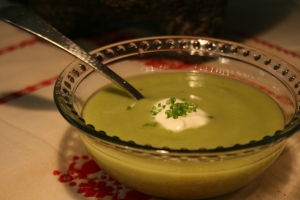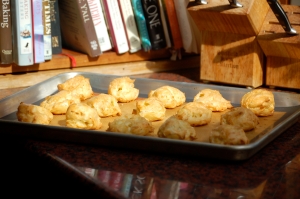by Kelsey Parris

Edgar Sierras' Plaintains Foster. Photo by Natalie Root Photography
New Orleans has always been a city that thrived on new people and cultures, absorbing the different traditions and foods and integrating them into the city’s own culture. La Louisiane was never a homogenous community, and its ability to accept different ethnicities and adapt to the land was key to its survival. French, Acadians, Germans, Spanish, Native Americans, and Africans were among those people who had to work together to create livable settlements. Food collaboration was an important part of making ends meet, and settlers learned how to produce and use native foods while introducing their own techniques and flavors, thus creating the cuisine of Louisiana Cajuns and Creole. Over the years, later immigrant populations brought their own cuisines, and some larger groups such as the Sicilians and Vietnamese were able to retain their culinary identity while adapting to the local styles and products.
Historically, New Orleans and Louisiana have been closely tied to Spain, Mexico, and Latin American countries. Even though Spain ruled the Louisiana territory from 1763 until 1803, Spanish speaking influences never seemed to be able to penetrate the dominant French culture. There are interesting exceptions to that rule, though, as the Isleños of Saint Bernard Parish show. Groups of Spanish Canary Islanders arrived in 1778 as part of the Spanish government’s plan to protect the city of New Orleans from hostile invasion from the British. It was thought that by settling sympathetic people in vulnerable areas, the threatened invasion of the English from the Eastern territory could be halted.
Although this invasion never quite came to pass, the Isleños settled throughout Louisiana, with a pretty serious concentration in St. Bernard Parish. Since it was a fairly insular community, a dialect of Spanish was spoken, and foods such as paella, empanadillos, flan, and candies, as well as a love of fresh fish and game were passed through the generations. Caldo is one example: a soup that is a traditional Canary Island staple, made with tons of fresh vegetables, beans, pork, and carefully guarded family recipes. The Isleños Museum in Chalmette chronicles the lives of this group, and also holds an annual festival, Los Isleños Fiesta, that celebrates the culture of the community. Spanish and Latin American immigrants must have appreciated the existence of the Spanish cultural community and it gradually expanded and crept into the city of New Orleans.
In 2005, a new threat was realized, and this time the British had nothing to do with it. New Orleans and Louisiana were devastated by Hurricane Katrina, and the area was again dependent on immigrant populations to help rebuild and repopulate the city and strengthen the culture that made it special. Latin Americans from Mexico, Honduras, and other Central American countries recognized the need for labor and the potential for good and steady income, and settled in New Orleans to man the rebuilding efforts.
Suddenly a great need for authentic Latin American food arose with this new influx of workers and their families. As the population settled in, the stores and restaurants that sprang up, stocking food supplies and brand names that the immigrants were familiar with, are usually owned and operated by native Spanish speakers who want to reach out and create a sense of community. Shelves overflow with peppers and tortillas, tamale wrappers and corn cakes. Thanks to the higher demand for food on the go, the food truck phenomenon has finally arrived in New Orleans through the now ubiquitous taco trucks.

Adolfo Garcia's LA Drum with Crabmeat Catacones and Avocado Remoulade. Photo by natalie Root Photography
In SoFAB’s newest exhibit, New Orleans con sabor Latino, photographer Natalie Root and curator Zella Llerena have gone through the city and the surrounding areas, finding people with Latin American ties, whether it be ancestral, like Isleños Mike and Donna, first generation, like Chef Adolfo Garcia, or recent arrivals to the city. Through their research, they have found through preparing their traditional food while incorporating elements of Louisiana’s foods, a new cuisine is evolving. Some home cooks add okra to their dishes, others use grits. In professional kitchens, chefs have brought flavors of their homes to the menu while weaving them into the bounty of Louisiana produce and seafood.
This is a cultural shift that seems like it will slowly integrate itself into the food and culture of New Orleans and Louisiana, and it is important to recognize the changes that are taking place, and to give credit to those who are helping to make it happen. In the same way that Sicilians and Vietnamese have gradually introduced their foods and communities through stores and restaurants to become part of the fabric of the region’s culture, Latin Americans are poised to settle in.
More reading…
Gambit’s article on Latin American Food stores: http://bestofneworleans.com/gyrobase/Content?oid=oid%3A49431
Slate’s article post-K about influx of Latin American workers: http://www.slate.com/id/2140224/entry/2140240
Rio Mar’s site and mission statement: http://www.riomarseafood.com/about-us/welcome/
John Folse’s Caldo
Prep Time: 2 Hours
Yields: 8 Servings
Ingredients:
1 pound white beans
1 pound diced ham
1 pound pickled meat or smoked sausage
1/2 cup vegetable oil
2 cups diced onions
1 cup diced celery
1 cup diced bell peppers
1/4 cup minced garlic
1 (8-ounce) can tomato sauce
1 gallon cold water
1 (15-ounce) can string beans
2 (15-ounce) cans mustard greens
2 (15-ounce) cans spinach
1 (15-ounce) can corn
1 (15-ounce) can peas
1 (15-ounce) can sweet potatoes
1 (15-ounce) can yellow squash
1 (15-ounce) can new potatoes
1 and 1/2 heads shredded cabbage2 ears corn
salt and black pepper to taste
Louisiana hot sauce to taste
Method:
In a 12-quart Dutch oven, heat oil over medium-high heat. Add ham and pickled meat and sauté until golden brown. Stir in onions, celery, bell peppers and minced garlic. Saute 3–5 minutes or until vegetables are wilted. Add white beans, tomato sauce and water. Bring mixture to a rolling boil and continue to cook 1 hour or until beans are tender. Blend in all canned vegetables along with cabbage and fresh corn. Continue to cook over medium heat approximately 30 minutes. Season to taste with salt, pepper and hot sauce. Additional water may be added to retain consistency during cooking. Serve as a soup over steamed white rice.
Recipe from WFAB.com










